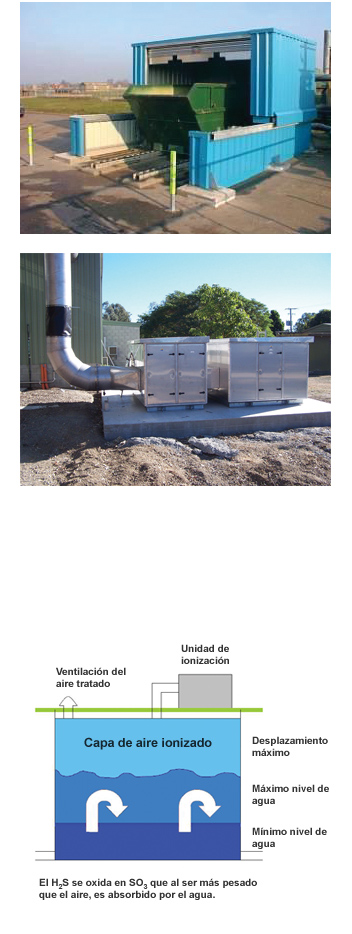 Terminodour odour abatement system uses ionised atmospheric air to neutralize bad odours present on different kinds of ambient, minimizing the maintenance costs of the traditional systems (carbon active, chemical scrubs…). It can be installed on:
Terminodour odour abatement system uses ionised atmospheric air to neutralize bad odours present on different kinds of ambient, minimizing the maintenance costs of the traditional systems (carbon active, chemical scrubs…). It can be installed on:
- Waste water: waste water treatment plants, pump stations…
- Industry: composting, sludge treatment…
- Food industry: stockbreeding, slaughterhouses…
The odour control system consists of:
- Filter, to avoid solids in the air flow.
- Fan, to create the air flow.
- Ionisation unit.
- Pipe works, to distribute the ionised air into the structure.
- Pipe works, to distribute the ionised air into the structure.
These kinds of systems can be installed inside or outside of the areas to treat.
Operation:
External air coming from the atmosphere is filtered and takes into a ionisation chamber, where Oxygen molecules are ionised, i.e., they acquire some electrical charge. This ionised air is distributed inside the chambers to treat the odour by a net of pipes. Then large chains of oxidation reactions happen, because the negative charged oxygen ions react with the odour molecules, positive charged. The result of these reactions is completely healthy air that is pushed to the atmosphere.
Description of the reaction
Ionisation unit charges air molecules (oxygen, nitrogen…), which usually are in neutral state. Terminodour ionisation units use alternate current to crate positive and negative ions. This high charged air can oxidize some kinds of gas compounds. In the presence of ionised air some oxidation process happen which turn chemical pollutant into its simplest form, completely oxidized.
Terminodour efficiency has been proved not only with Hydrogen sulphide (H2S), but with some odour compounds (mercaptans, ammonia, amines, some volatile organic compounds…). Final products got from the odour oxidation are completely benign (CO2, nitrogen and water vapour), and can be throw out to the atmosphere.
With balanced production of positive and negative ions, Terminodour system prevents overload on suspension particles. Although, maintaining a neutral layer over them, these particles will tend to stay in suspension to be later discharged to the atmosphere. This prevents dust accumulation over the surfaces.
Advantages
Operational costs of the system are too low, and the only associated maintenance with the process is cleaning the filters and ionisation tubes quarterly.


